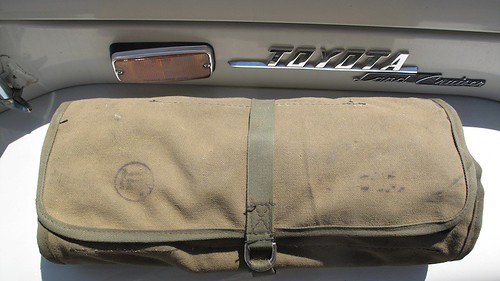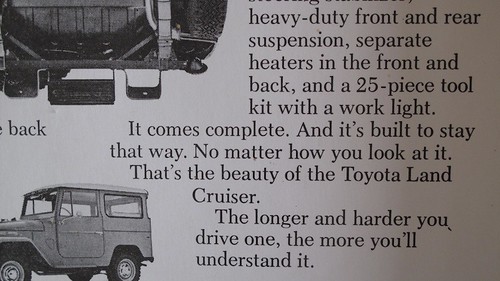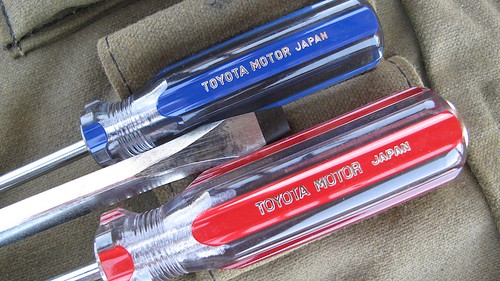The Holy Grail of factory tool kits

Who remembers when new four-wheel-drive vehicles came with any factory tools beyond a cheesy scissors jack and a dog-leg lug-nut wrench, and maybe an OnStar account?
It wasn’t always that way. In the halcyon days of Series II and III Land Rovers and 40-Series Land Cruisers, it wasn’t considered a sign of weakness or a failure of the accounting department to acknowledge that hard-working vehicles needed maintenance and repair now and then, and it was presumed that the owners of those vehicles would be doing a good bit of that work themselves. A decent tool kit was a selling point that actually showed up in ads. (The only automotive corollary I can think of is the exquisite trunk-lid tool kits that used to come with high-end BMW sedans. I'm not sure how many of those saw any owner use . . . )

When I bought my 1973 FJ40 Land Cruiser, the excellent factory tool kit was still in place and complete. It included screwdrivers, wrenches, a spark-plug tool, and more, in a vinyl roll that stored under the driver’s seat. Sadly I can’t furnish a complete inventory or photo, because it was stolen when I stupidly left the vehicle unlocked one night. Since this was before eBay and Craigslist, I simply fumed and vowed to find another some day. It’s not like I didn’t have plenty of other tools, but the Land Cruiser just felt incomplete without its own kit.
Then, about ten years ago, I happened to stop by the shop of the local lord of Land Cruiser used parts, set amidst a sprawling three-acre compound of partially disassembled vehicles. An old shipping container next to the shop was a sort of trove of odd and rare bits. As we were looking for a turn signal switch to fit my 40, Tim said, “Aren’t you interested in factory tool kits?” I allowed as to how I was, and his eyes twinkled. “Then I have something for you.” He ducked into the container and brought out a roll—oiled canvas rather than vinyl, redolent of the military surplus store I worked at after high school—and laid it on the workbench. It seemed fatter than I remembered my old kit, and when he unrolled it I saw why.

“Never seen another quite like it,” said Tim. And neither had I.
Nestled in stitched pockets was a superb selection of Toyota-branded tools, still sticky with cosmoline preservative. In addition to the screwdrivers and wrenches I remembered from my kit, this one added a wood-handled ball pein hammer, pliers, a crescent wrench, a compact grease gun, and, in a little pocket on the side, a plastic bag, still sealed, filled with a selection of spare fasteners: bolts, nuts, and washers, and a wheel stud. That last piece proved beyond doubt that someone who knew what was likely to go wrong in the bush had assembled this kit.

In true orderly Japanese fashion, a clear corner sleeve held a numbered content list.

One thing I’ve never been any good at is cool bargaining. I knew Tim already knew this, so I just sighed and said, “How much?” He named a price that was . . . high. Absurdly high. High enough that I would have been insane not to walk away and pick up an equivalent assortment from a Snap-on tool truck for the same price.
So I said, “Okay.”
At least now my FJ40 once again boasts its own proper set of branded tools.
That is, when I work up the nerve to bring them along. They’re worth too damned much to actually use.
 One thing that wasn't stolen from the original kit was the trouble light, stored in the glove box. Its 39-year-old bulb still works.
One thing that wasn't stolen from the original kit was the trouble light, stored in the glove box. Its 39-year-old bulb still works.
(Got a vintage - or otherwise - vehicle with a proper tool kit? Send me a photo.)
